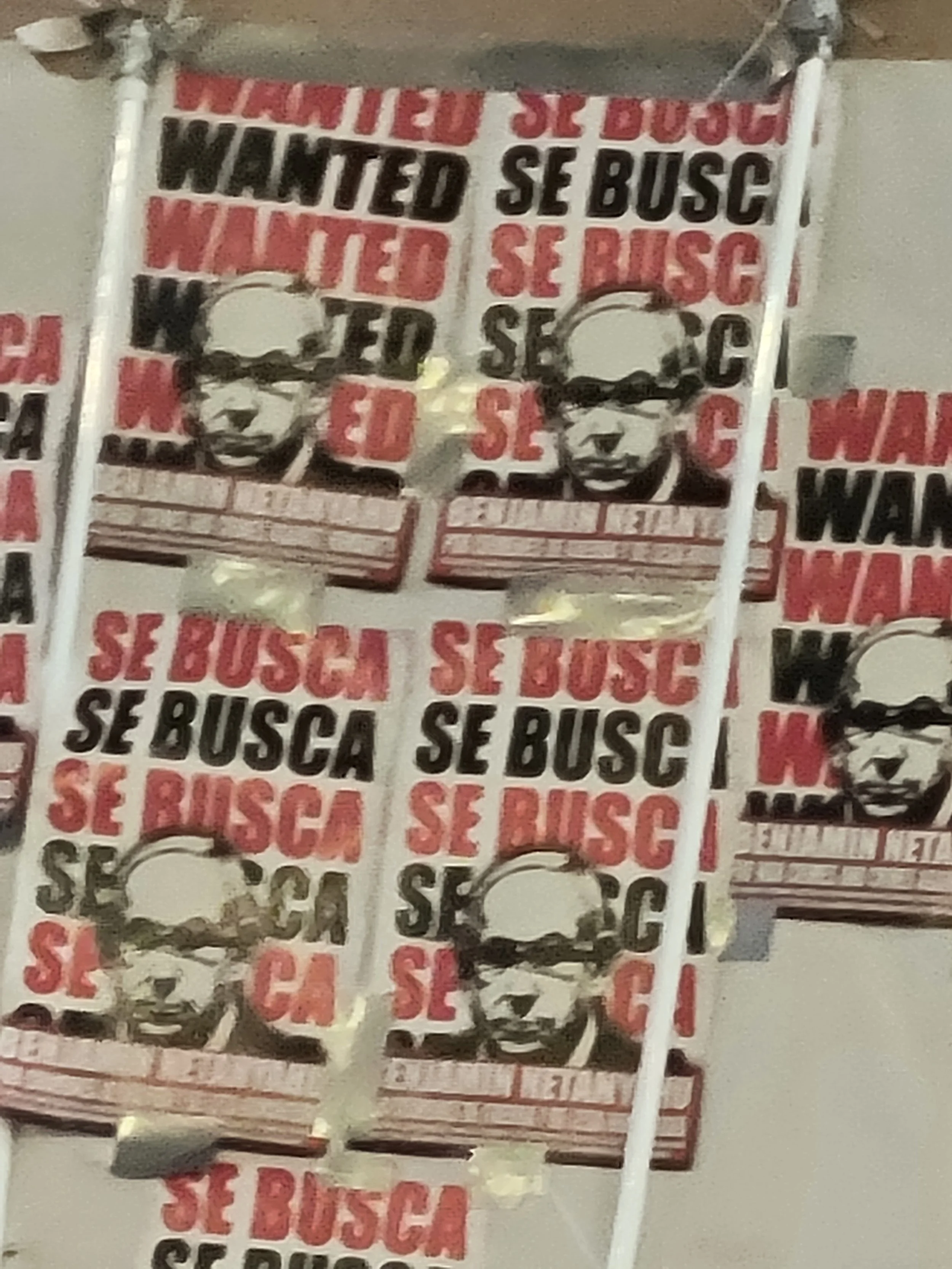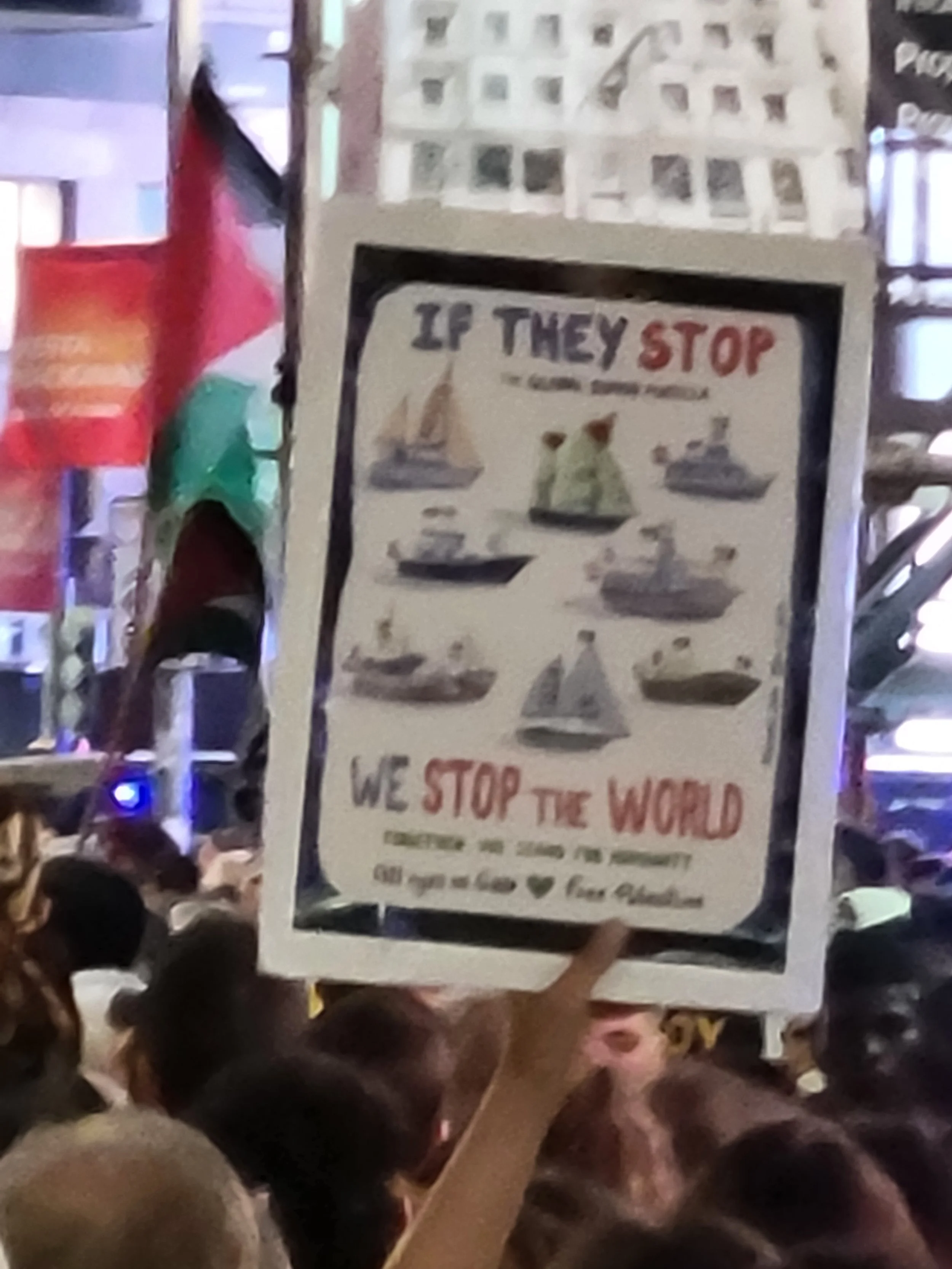Beyond the Bullfights: Madrid Rises Again for Palestine
Marchers in Madrid gather at the start of the October 4 mass protest in solidarity with Palestine. (Photo: John Collins/Weave News)
From my neighborhood in Madrid, it’s easy to get to the city center from the subway station at Ventas, located right next to the city’s famed Plaza de Toros (bullring). On the afternoon of October 4, the entire area was clogged with people gathering for a Saturday corrida (bullfight), and the contrast with the thousands who would soon take over the streets of central Madrid to demand an end to the genocide in Gaza could not have been more stark. It symbolized, in many ways, an emergent reality in which an indignant global majority determined to see a free Palestine is pitted against a stubborn ruling class determined to defend centuries-old privileges and prop up a murderous, dystopian system of techno-feudalism.
I could write forever about that dynamic. But as a wise friend once told me, it is also important to try to “write from the exit” sometimes.
The culture wars, here and there
They came pouring out of the station at Ventas dressed like they were heading to Easter brunch. Young men with identical haircuts and gold crosses around their necks swaggered up the stairs laughing loudly with their buddies while young women in late summer dresses giggled and took selfies on their way to the bullring. All around them, parents and grandparents strolled arm in arm in carefully pressed shirts and skirts. They were in their element, strutting into what amounts to a kind of mini-Disneyland for Spanish traditionalists. Do they think it’s still 1955? Do they want to Make Spain Great Again?
Crowds gather at Madrid’s Plaza de Toros in the hour leading up to a weekend bullfighting session. (Photo: John Collins/Weave News)
I was instantly reminded of those classic photos from my Wisconsin homeland: local residents tailgating at Green Bay Packers football games, dressed in their Sunday best regardless of the cold weather. Today, many fans who lean conservative like to invoke the words of legendary Packers coach Vince Lombardi, who often insisted on the importance of “God, family, and football - in that order.” Eager to yoke this legacy to their vision of patriarchal order, they conveniently forget that Lombardi was also a champion of racial equality and an active supporter of gay athletes. Football in Wisconsin, in other words, contains all of the contradictions that are present in the wider society.
The same dynamic is at work in Spain, where bullfighting occupies a key place in a simmering culture war that permeates daily life and discourse in the news and in the streets. You see this in the open spaces and the bars surrounding the Plaza de Toros, where Spanish flags are as ubiquitous as photos of heroic bullfighters. The Right has worked hard to fuse the meaning of bullfighting, and of traditional culture in general, to their broader political project. Yet this strategy is always in danger of breaking down as there are also many Spaniards on the other end of the political spectrum who appreciate elements of traditional culture.
Now, into this dynamic and sometimes combustible mix, add Palestine.
Palestine in the subway
Trying to make our way through the bullfighting crowd, down the stairs, and into the station was like wading through a sepia-toned newsreel. Once we managed to do that, however, everything changed. As we waited on the platform for the train that would take us downtown, we realized that almost everyone around us was also headed to the protest. A middle-aged woman in front of us had carefully put together an outfit to reflect the colors of the Palestinian flag: red shoes, green pants, a black shirt, and a white scarf. Young people fired up about standing up for Gaza mingled easily with older folks talking quietly.
They were also in their element: a diverse, colorful, decidedly working-class and middle-class scene where tattoos and colorful hairdos coexisted with baseball caps, small backpacks, and sensible shoes. Palestine t-shirts, kufiyas, and watermelon iconography were everywhere.
In other words, the subway station at that moment was a kind of temporary meeting point where the difference between these two visions of Spain and the world came into sharp relief. As one group surged up the stairs and the other descended, the friction between their bodies symbolized something altogether more profound and weighty.
Palestine occupies Madrid
We decided to get off the train at Estación del Arte, which is one stop before the major intersection where the Gaza march was slated to begin. Everyone else had the same idea. As we inched our way from the train, through a claustrophobic passageway, and toward the exit up to the street level, someone started an energetic “Free, Free Palestine!” chant. Some 15 minutes later, we started to feel the fresh air and finally emerged onto the street, just a stone’s throw from the Reina Sofia museum, where Pablo Picasso’s Guernica (one of the greatest works of citizen journalism ever produced) is housed.
Passengers exiting the train and heading for the protest march were packed like sardines as they waited to exit the subway station. (Photo: John Collins/Weave News)
The march was, as Spaniards often say, multitudinaria (massive). It took close to an hour before the crowd packed into the street even began to move. How big was the crowd? Estimates vary from 100,000 (which seemed a clear under-estimate from local officials) to 400,000 (the number provided by organizers). Aerial footage from independent newsroom El Salto suggests that the organizers were closer to the truth:
The flotilla’s impact
Spain has seen large actions in solidarity with Palestine through the post-October 7 period - I’ve covered some of them in Madrid and Malaga for Weave News - but there’s no question that yesterday’s march represented a major expansion in what is becoming a tidal wave of popular outrage. This outrage is obviously directed first and foremost at the Israeli government, and Prime Minister Netanyahu in particular, but it extends to other governments in the US and Europe that have actively fueled Israeli violence. In addition to chants in support of the Palestinian struggle, there were numerous slogans and signs decrying Netanyahu as a murderer and war criminal, castigating President of the Community of Madrid Isabel Díaz Ayuso for her strong support of Israel (one clever sign referred to her as “Israel Díaz Ayuso), and demanding that the Spanish and other European governments cut off all material and diplomatic relations with the apartheid state.
Many marchers carried signs condemning Netanyahu and insisting that history will judge him as a war criminal. (Photo: John Collins/Weave News)
While reliable constituencies such as students, unions, activist retirees, and various parties on the Left were heavily represented at the march, even a cursory look at the crowd revealed the presence of thousands of Spaniards whose participation was perhaps more novel. It felt like a proverbial tipping point, especially when combined with the huge marches taking place in Italy, Turkey, Tunisia, and other countries around the Mediterranean and throughout Western Europe.
Some of the folks who were marching with me attributed this groundswell of solidarity with Palestine to two main factors. First, they said, images of starving Palestinians - especially children - had sparked a reaction from people who don’t think of themselves as activists. Signs emphasizing the importance of valuing “humanity” over narrower identities signaled the presence of these newcomers. Second, the story of the Global Sumud Flotilla - which included 49 Spanish participants, just one short of the Turkish contingent that was the largest in the flotilla - has absolutely captured the public imagination in Spain through viral videos, livestreams, and more traditional media coverage.
One of many signs at the Madrid march referencing the Global Sumud Flotilla. (Photo: John Collins/Weave News)
Following the money
Another essential element of the growing global Palestine solidarity movement is the efforts of citizen-activists to draw connections between Israeli state violence and those who support and profit from it. As the march made its way through the city center and down the Gran Vía (one of the city’s main tourist and shopping arteries), it became clear that some activists had taken the opportunity to mete out some popular justice to several prominent global brands, adorning their shop windows with spray paint and stickers accusing them of being accomplices to genocide.
Stickers and spray paint on the windows of Starbucks, Zara, and Burger King locations along Madrid’s Gran Via. (Photo: John Collins/Weave News)
In a further sign of a maturing movement that is increasingly focused on using all available levers to exert grassroots pressure, some marchers were actively promoting the idea of a general strike, echoing the approach of activists in Italy. As of this writing, organizers in Spain are actively exploring the idea of trying to pull off a general strike as early as October 15, an ambitious goal that would require the collaboration of major unions.
Marchers carried a banner calling for a general strike in support of Palestine. (Photo: John Collins/Weave News)
How to read a flag
There was one additional element of the Madrid march that caught my attention and brought me back to what I had seen at the Plaza de Toros. In one section of the crowd at the march, there were probably 10-12 people each simultaneously carrying two flags: the Palestinian flag (which obviously dominated the march as a whole) and the Spanish flag. The latter is almost never seen at any progressive action in Madrid; indeed, given the flag’s association with the modern state formed as a monarchy, it is much more common for those on the Left to carry the flag of the Second Spanish Republic - still a potent symbol of the country’s anti-monarchist and radically democratic traditions.
So, why were some people carrying Spanish flags along with Palestinian ones at a march opposing genocide in Gaza? Was this a sign that the Right is stepping up efforts to infiltrate and disrupt the pro-Palestine movement? When asked, one of the marchers carrying the Spanish flag insisted that no, he wasn’t a conservative at all. On the contrary, he emphasized that he and his colleagues wanted to contest the Right’s efforts to monopolize the symbol of the flag.
Marchers carrying Palestinian and Spanish flags simultaneously. (Photo: John Collins/Weave News)
While this is a tough sell for many on the Left who remain committed to transforming the very nature of the Spanish state, his explanation got me thinking about the “traditionalists” who so eagerly attend Madrid’s bullfights. Most are undoubtedly supporters of conservative parties such as Vox and the Popular Party (PP). And given the polarized nature of politics in Spain, where supporting a party is often treated as akin to cheering for a football team, there is tremendous pressure for citizens to fall into line on the full range of culture war topics that often distract from necessary debates about bread-and-butter issues.
When it comes to Palestine, I’m sure that many on the Right truly agree with the pro-Israel talking points spouted by the parties they support. They have bought into the idea that Israel is simply fighting “terrorism” and that all Palestinian suffering can be traced to Hamas. They may also agree with Vox leader Santiago Abascal when he speaks of the necessity of defending “civilization” (read: his image of a white, Christian, patriarchal, anti-immigrant, Islamophobic “civilization”) against its perceived enemies.
More images from the Madrid march
Having said that, I also want to believe that some of these “traditionalists,” in their heart of hearts, are not in favor of genocide, nor of bombing hospitals and schools, nor of subjecting civilian populations to mass starvation. The pressure to perform their ideological loyalty - the Left is marching for Palestine, therefore we on the Right must support Israel - may be creating some cognitive and moral dissonance for them. If so, that dissonance should be cultivated. Perhaps it is naive to think that a few Spanish flags at a Palestine march could offer such people an opening to listen to their conscience. But perhaps not…
Palestine as the common sense of humanity
I don’t claim to know for sure why those Spanish flags were there. For all I know, the people carrying them may have been colleagues of the plainclothed police officers who are scattered throughout any major march in Madrid. But the presence of those flags still serves as a reminder that there is always more room for common ground than the culture warriors want us to believe.
All of this leads me to say: Thanks to the flotilla - and, even more, to the unfathomably courageous efforts of Palestinians themselves to document what is happening to them on the ground - Palestine is now starting to occupy a place of common human sense that stretches beyond the old ideological battles. On the most immediate level, this opens a door to build bridges with those who hold certain kinds of “traditional” values (maybe even those who love bullfighting).
On a broader level, it represents an opportunity to build a shared understanding of how the marriage of profit, militarism, and technology is a dead end for all of us.






















